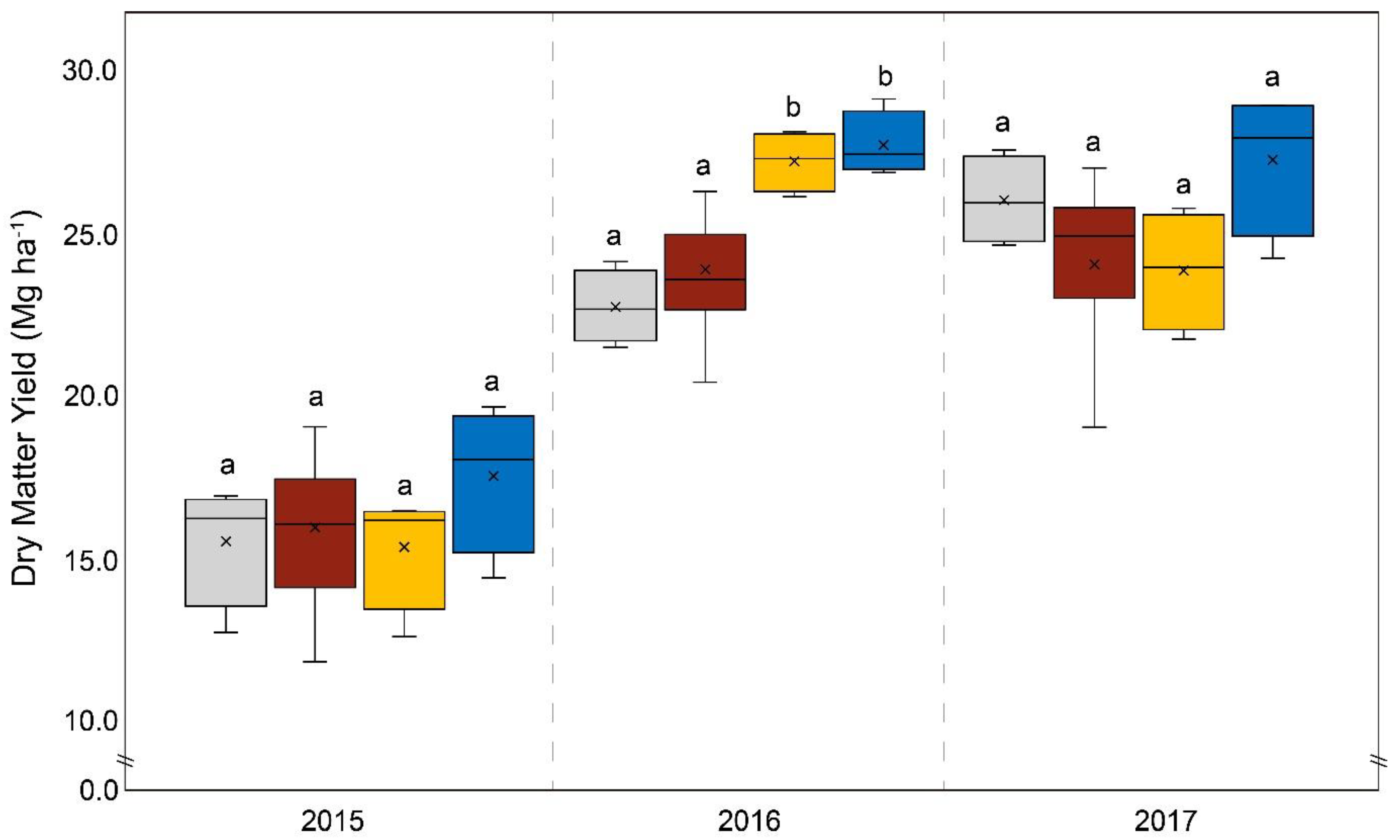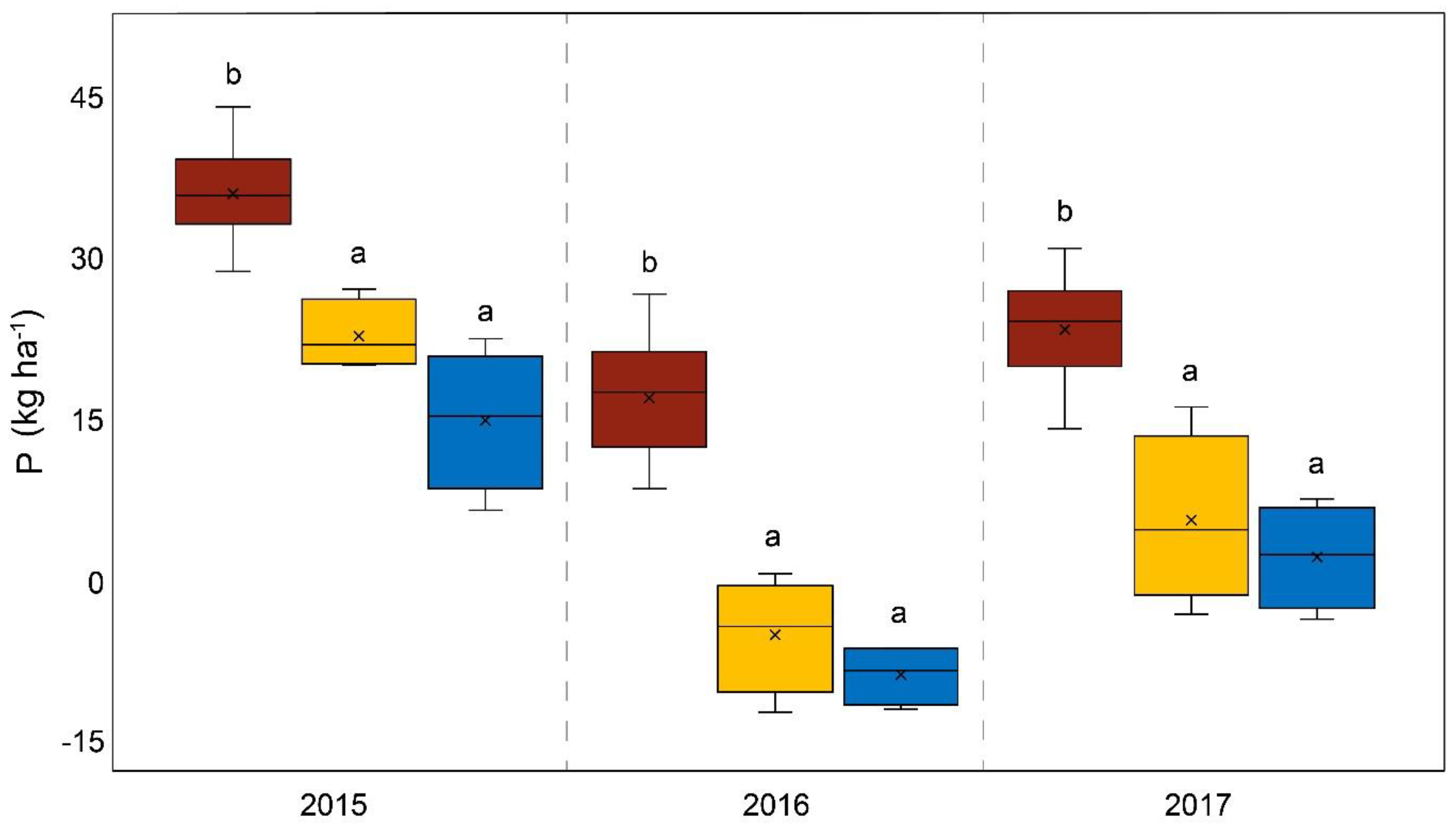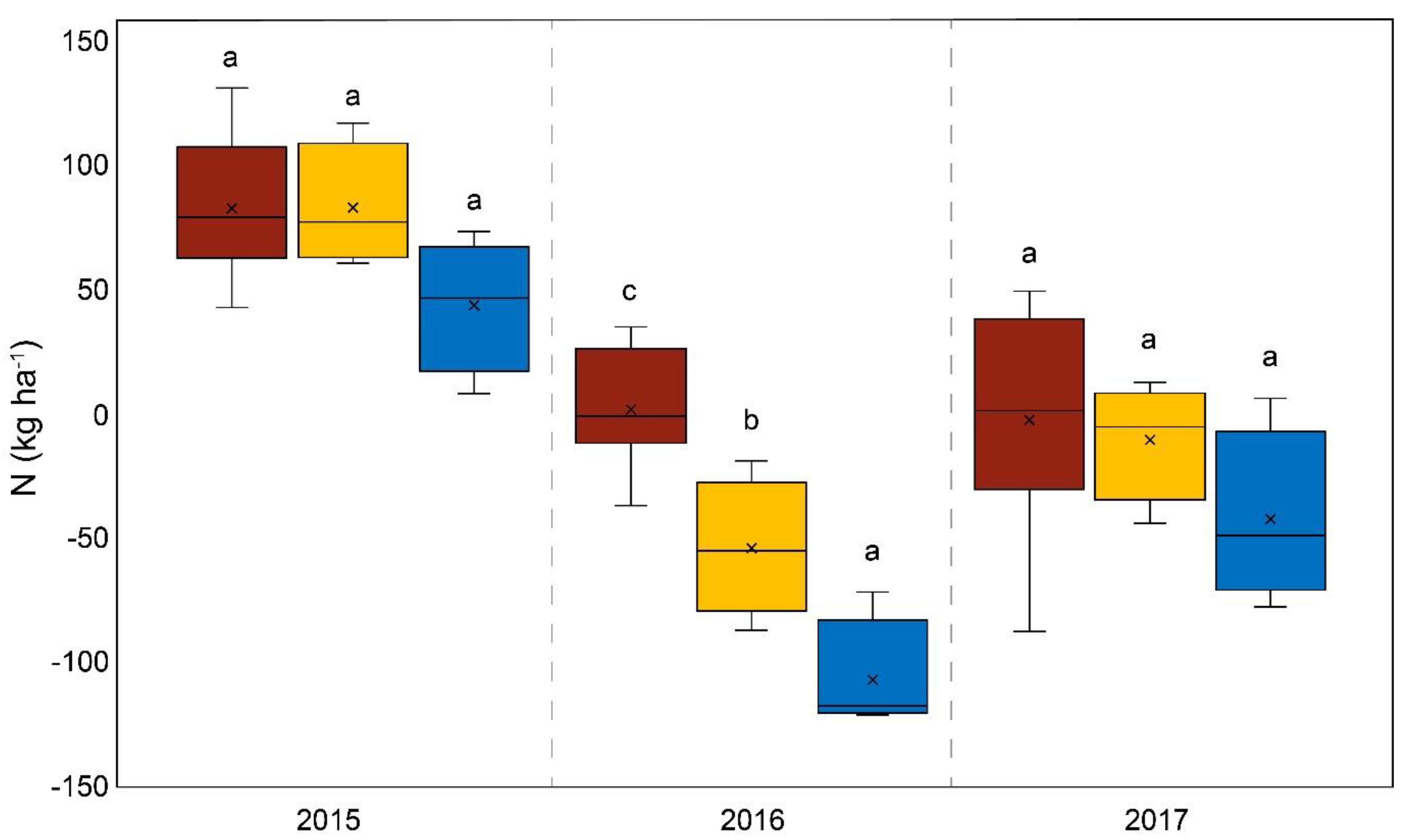The Potential of Microgranular Fertilizers to Reduce Nutrient Surpluses When Growing Maize (Zea mays) in Regions with High Livestock Farming Intensity
Abstract
1. Introduction
2. Materials and Methods
2.1. The Study Area and Experimental Setup
2.2. Data Sampling and Statistical Analysis
3. Results
3.1. The Effect of Microgranular Fertilizer on Dry Matter Yield and Nutrient Balances
3.2. Economic Analysis of DAP and the Startec Organomineral Microgranular Fertilizing System
4. Discussion
4.1. Comparing Yield and Nutrient Balances with DAP and Microgranule Fertilization
4.2. Economic Consideration of DAP and the Startec Organomineral Microgranular Fertilizing System
5. Conclusions
Author Contributions
Funding
Institutional Review Board Statement
Informed Consent Statement
Data Availability Statement
Conflicts of Interest
References
- Torrent, J.; Barberis, E.; Gil-Sotres, F. Agriculture as a source of phosphorus for eutrophication in southern Europe. Soil Use Manag. 2007, 23, 25–35. [Google Scholar] [CrossRef]
- Ulén, B.; Bechmann, M.; Fölster, J.; Jarvie, H.P.; Tunney, H. Agriculture as a phosphorus source for eutrophication in the north-west European countries, Norway, Sweden, United Kingdom and Ireland: A review. Soil Use Manag. 2007, 23 (Suppl. S1), 5–15. [Google Scholar] [CrossRef]
- Edixhoven, J.D.; Gupta, J.; Savenije, H.H. Recent revisions of phosphate rock reserves and resources: A critique. Earth Syst. Dyn. 2014, 5, 491–507. [Google Scholar] [CrossRef]
- Kisinyo, P.; Opala, P. Depletion of phosphate rock reserves and world food crisis: Reality or hoax? Afr. J. Agric. Res. 2020, 16, 1223–1227. [Google Scholar] [CrossRef]
- Top Agrar Online. Landwirtschaftsverlag GmbH, D-48084 Münster. Export von Wirtschaftsdünger aus Weser-Ems Erreicht Neuen Rekord. Available online: https://www.topagrar.com/schwein/news/export-von-wirtschaftsduenger-aus-weser-ems-erreicht-neuen-rekord-10121945.html (accessed on 31 July 2023).
- NABU (Naturschutzbund Deutschland) e.V. Düngung aus den Fugen. Available online: https://www.nabu.de/natur-und-landschaft/landnutzung/landwirtschaft/umweltschutz/22854.html (accessed on 31 July 2023).
- Alley, M.M.; Reiter, S.; Thomason, W.E.; Reiter, M.S. Pop-up and/or Starter Fertilizers for Corn; Virginia State University: Petersburg, VA, USA, 2010. [Google Scholar]
- Mondini, C.; Cayuela, M.L.; Sinicco, T.; Sánchez-Monedero, M.A.; Bertolone, E.; Bardi, L. Soil application of meat and bone meal. Short-term effects on mineralization dynamics and soil biochemical and microbiological properties. Soil Biol. Biochem. 2008, 40, 462–474. [Google Scholar] [CrossRef]
- Ramachandran, S.; Singh, S.K.; Larroche, C.; Soccol, C.R.; Pandey, A. Oil cakes and their biotechnological applications—A review. Bioresour. Technol. 2007, 98, 2000–2009. [Google Scholar] [CrossRef]
- Balawejder, M.; Szostek, M.; Gorzelany, J.; Antos, P.; Witek, G.; Matłok, N. A study on the potential fertilization effects of microgranule fertilizer based on the protein and Calcined bones in maize cultivation. Sustainability 2020, 12, 1343. [Google Scholar] [CrossRef]
- Olbrycht, M.; Kołodziej, M.; Bochenek, R.; Przywara, M.; Balawejder, M.; Matłok, N.; Antos, P.; Piątkowski, W.; Antos, D. Mechanism of nutrition activity of a microgranule fertilizer fortified with proteins. BMC Plant Biol. 2020, 20, 126. [Google Scholar] [CrossRef]
- Kaiser, D.E.; Mallarino, A.P.; Bermudez, M. Corn grain yield, early growth, and early nutrient uptake as affected by broadcast and in-furrow starter fertilization. Agron. J. 2005, 97, 620–626. [Google Scholar] [CrossRef]
- Quinn, D.J.; Poffenbarger, H.J.; Leuthold, S.J.; Lee, C.D. Maize response to in-furrow fertilizer and fungicide across rye cover crop termination timings. Agron. J. 2021, 113, 3384–3398. [Google Scholar] [CrossRef]
- Blandino, M.; Battisti, M.; Vanara, F.; Reyneri, A. The synergistic effect of nitrogen and phosphorus starter fertilization sub-surface banded at sowing on the early vigor, grain yield and quality of maize. Eur. J. Agron. 2022, 137, 126509. [Google Scholar] [CrossRef]
- Bermudez, M.; Mallarino, A.P. Yield and early growth responses to starter fertilizer in no-till corn assessed with precision agriculture technologies. Agron. J. 2002, 94, 1024–1033. [Google Scholar] [CrossRef]
- Fernandez, J.Q.P.; Dias, L.E.; Barros, N.F.; Novais, R.F.; Moraes, E.J. Productivity of Eucalyptus camaldulensis affected by rate and placement of two phosphorus fertilizers to a Brazilian Oxisol. For. Ecol. Manag. 2000, 127, 93–102. [Google Scholar] [CrossRef]
- Niehues, B.J.; Lamond, R.E.; Godsey, C.B.; Olsen, C.J. Starter nitrogen fertilizer management for continuous no-till corn production. Agron. J. 2004, 96, 1412–1418. [Google Scholar] [CrossRef]
- Quinn, D.J.; Lee, C.D.; Poffenbarger, H.J. Corn yield response to sub-surface banded starter fertilizer in the US: A meta-analysis. Field Crops. Res. 2020, 254, 107834. [Google Scholar] [CrossRef]
- Nelson, L.B. The mineral nutrition of corn as related to its growth and culture. Adv. Agron. 1956, 8, 321–375. [Google Scholar]
- Welch, L.F.; Mulvaney, D.L.; Boone, L.V.; McKibben, G.E.; Pendleton, J.W. Relative efficiency of broadcast vs. banded phosphorus for corn. Agron. J. 1966, 58, 283–287. [Google Scholar] [CrossRef]
- Preston, C.L.; Ruiz Diaz, D.A.; Mengel, D.B. Corn response to long-term phosphorus fertilizer application rate and placement with strip-tillage. Agron. J. 2019, 111, 841–850. [Google Scholar] [CrossRef]
- Köppen, W.; Geiger, R. Handbuch der Klimatologie, 1. Auflage; Gebrüder Bornträger: Berlin, Germany, 1930. [Google Scholar]
- Schüller, H. The CAL method, a new method for determining the phosphate available to plants in soils. Plant Nutr. 1969, 123, 48–63. [Google Scholar] [CrossRef]
- Wickham, H.; François, R.; Henry, L.; Müller, K. dplyr: A Grammar of Data Manipulation. R Package Version 0.7.6. 2018. Available online: https://CRAN.R-project.org/package=dplyr (accessed on 21 March 2022).
- Wickham, H. ggplot2: Elegant Graphics for Data Analysis; Springer: NewYork, NY, USA, 2009. [Google Scholar]
- VDLUFA I. A6.2.1.2. Bestimmung von Phosphor und Kalium im Doppellactat (DL)—Auszug. In VDLUFA Methodenbuch; 4. Auflage. Band 1 Die Untersuchung von Böden; VDLUFA-Verlag: Darmstadt, Germany, 1991.
- Németh, K. Determination of desorption and solubility rates of nutrients in the soil by means of electroultrafiltration (EUF). In Proceedings of the 9th Colloquium of the International Potash Institute, Landshut, Germany, 1972. [Google Scholar]
- Sharpley, A. Phosphorus availability. In Handbook of Soil Science; CRC Press: Boca Raton, FL, USA, 1999; pp. D18–D37. [Google Scholar]
- Eichler-Loebermann, B.; Zicker, T.; Kavka, M.; Busch, S.; Brandt, C.; Stahn, P.; Miegel, K. Mixed cropping of maize or sorghum with legumes as affected by long-term phosphorus management. Field Crops Res. 2021, 265, 108120. [Google Scholar] [CrossRef]
- Hu, Y.; Jarosch, K.A.; Kavka, M.; Eichler-Löbermann, B. Fate of P from organic and inorganic fertilizers assessed by complementary approaches. Nutr. Cycl. Agroecosyst. 2022, 124, 189–209. [Google Scholar] [CrossRef]
- Soppelsa, S.; Kelderer, M.; Casera, C.; Bassi, M.; Robatscher, P.; Andreotti, C. Use of biostimulants for organic apple production: Effects on tree growth, yield, and fruit quality at harvest and during storage. Front. Plant Sci. 2018, 9, 1342. [Google Scholar] [CrossRef]
- Thielicke, M.; Ahlborn, J.; Životić, L.; Saljnikov, E.; Eulenstein, F. Microgranular fertilizer and biostimulants as alternatives to diammonium phosphate fertilizer in maize production on marshland soils in northwest Germany. Zemlj Biljka 2022, 71, 53–66. [Google Scholar] [CrossRef]
- Govarthanan, M.; Park, S.H.; Park, Y.J.; Myung, H.; Krishnamurthy, R.R.; Lee, S.H.; Lovanh, N.; Kamala-Kannan, S.; Oh, B.T. Lead biotransformation potential of allochthonous Bacillus sp. SKK11 with sesame oil cake extract in mine soil. RSC Adv. 2015, 67, 54564–54570. [Google Scholar] [CrossRef]
- Liu, X.; Selonen, V.; Steffen, K.; Surakka, M.; Rantalainen, A.L.; Romantschuk, M.; Sinkkonen, A. Meat and bone meal as a novel biostimulation agent in hydrocarbon contaminated soils. Chemosphere 2019, 225, 574–578. [Google Scholar] [CrossRef]
- Araújo, F.F.; Henning, A.A.; Hungria, M. Phytohormones and antibiotics produced by Bacillus subtilis and their effects on seed pathogenic fungi and on soybean root development. World J. Microbiol. Biotechnol. 2005, 21, 1639–1645. [Google Scholar] [CrossRef]
- Buzo, F.d.S.; Garcia, N.F.S.; Garé, L.M.; Gato, I.M.B.; Martins, J.T.; Martins, J.O.M.; Morita, P.R.d.S.; Silva, M.S.R.d.A.; Sales, L.Z.d.S.; Nogales, A.; et al. Phosphate Fertilization and Mycorrhizal Inoculation Increase Corn Leaf and Grain Nutrient Contents. Agronomy 2022, 12, 1597. [Google Scholar] [CrossRef]
- Cavaglieri, L.; Orlando, J.R.M.I.; Rodríguez, M.I.; Chulze, S.; Etcheverry, M. Biocontrol of Bacillus subtilis against Fusarium verticillioides in vitro and at the maize root level. Res. Microbiol. 2005, 156, 748–754. [Google Scholar] [CrossRef]
- Fan, B.; Wang, C.; Song, X.; Ding, X.; Wu, L.; Wu, H.; Gao, X.; Borris, R. Bacillus velezensis FZB42 in 2018: The Gram-Positive Model Strain for Plant Growth Promotion and Biocontrol. Front. Microbiol. 2018, 9, 2491. [Google Scholar] [CrossRef]
- Kloepper, J.W.; Leong, J.; Teintze, M.; Schroth, M.N. Enhanced plant growth by siderophores produced by plant growth-promoting rhizobacteria. Nature 1980, 286, 885–886. [Google Scholar] [CrossRef]
- Nacoon, S.; Jogloy, S.; Riddech, N.; Mongkolthanaruk, W.; Ekprasert, J.; Cooper, J.; Boonlue, S. Combination of arbuscular mycorrhizal fungi and phosphate solubilizing bacteria on growth and production of Helianthus tuberosus under field condition. Sci. Rep. 2021, 11, 6501. [Google Scholar] [CrossRef] [PubMed]
- Fikry, A.M.; Radhi, K.S.; Abourehab, M.A.S.; Abou Sayed-Ahmed, T.A.M.; Ibrahim, M.M.; Mohsen, F.S.; Abdou, N.A.; Omar, A.A.; Elesawi, I.E.; El-Saadony, M.T. Effect of Inorganic and Organic Nitrogen Sources and Biofertilizer on Murcott Mandarin Fruit Quality. Life 2022, 12, 2120. [Google Scholar] [CrossRef]
- Wang, J.; Zhang, X.; Yuan, M.; Wu, G.; Sun, Y. Effects of Partial Replacement of Nitrogen Fertilizer with Organic Fertilizer on Rice Growth, Nitrogen Utilization Efficiency and Soil Properties in the Yangtze River Basin. Life 2023, 13, 624. [Google Scholar] [CrossRef]
- Zhao, Y.; Hu, K.; Yu, J.; Khan, M.T.A.; Cai, Y.; Zhao, X.; Zheng, Z.; Hu, Y.; Cui, Z.; Wang, X. Biogas Residues Improved Microbial Diversity and Disease Suppression Function under Extent Indigenous Soil Microbial Biomass. Life 2023, 13, 774. [Google Scholar] [CrossRef]
- Landwirtschaftskammer Nordrhein-Westfalen. Was Ist in der Gülle Enthalten? Available online: https://www.landwirtschaftskammer.de/landwirtschaft/ackerbau/duengung/guelle/duenger/guelleinhaltsstoffe.htm (accessed on 31 July 2023).



| Nutrient Type and Input Rate per Hectare | |||||||||
|---|---|---|---|---|---|---|---|---|---|
| Fertilizer (Type 1) | Application Rate per Hectare in kg | N | P | K | S | Mg | Fe | Mn | Zn |
| Diammonium phosphate (mineral fertilizer) | 100 | 18 | 20 | - | - | - | - | - | - |
| Wolf Trax Nu-Trax P+® (mineral microgranular fertilizer) | 100 | 11 | 0.2 | - | 8.8 | 7.5 | - | 0.4 | 0.1 |
| Startec (organomineral microgranular fertilizer) | 25 | 1.75 | 2.4 | 0.8 | 1 | - | 0.125 2 | 0.125 2 | 0.375 2,3 |
| Pre-treatment of the whole study site with pig slurry (also used as control) | 20,000 | 172 | 39 | 98 | 48 | 21.6 | - | - | - |
| No. | Keywords | Agroeconomic Calculation of Flexible Fertilizer-Specific Factors per Hectare | |||
|---|---|---|---|---|---|
| DAP | Startec | ||||
| 1 | Cost | €40 | €60 | ||
| 2 | P balance (excess) | 25.5 kg | 2.7 kg | ||
| 3 | kg above permitted P excess * | 21.2 kg | 0.0 kg | ||
| 4 | Excess volume of slurry | 8.6 m3 | 0.0 m3 | ||
| 5 | Additional costs for slurry removal ** | €41.11 | €0.00 | ||
| Interim result for total costs | €82.11 | €60.00 | |||
| 6 | Fresh matter yield | 60.99 Mg | 69.23 Mg | ||
| 7 | Loss through ensilage | 12% | 12% | ||
| 8 | Silage yield | 53.67 Mg | €1878.45 | 60.92 Mg | €2132.20 |
| 9 | Remaining profit minus expenses | €1796.34 | €2072.20 | ||
| 10 | Surplus compared to DAP fertilization | - | €275.86 | ||
| Cost–benefit ratio | 0.044 | 0.028 | |||
Disclaimer/Publisher’s Note: The statements, opinions and data contained in all publications are solely those of the individual author(s) and contributor(s) and not of MDPI and/or the editor(s). MDPI and/or the editor(s) disclaim responsibility for any injury to people or property resulting from any ideas, methods, instructions or products referred to in the content. |
© 2024 by the authors. Licensee MDPI, Basel, Switzerland. This article is an open access article distributed under the terms and conditions of the Creative Commons Attribution (CC BY) license (https://creativecommons.org/licenses/by/4.0/).
Share and Cite
Eulenstein, F.; Ahlborn, J.; Thielicke, M. The Potential of Microgranular Fertilizers to Reduce Nutrient Surpluses When Growing Maize (Zea mays) in Regions with High Livestock Farming Intensity. Life 2024, 14, 81. https://doi.org/10.3390/life14010081
Eulenstein F, Ahlborn J, Thielicke M. The Potential of Microgranular Fertilizers to Reduce Nutrient Surpluses When Growing Maize (Zea mays) in Regions with High Livestock Farming Intensity. Life. 2024; 14(1):81. https://doi.org/10.3390/life14010081
Chicago/Turabian StyleEulenstein, Frank, Julian Ahlborn, and Matthias Thielicke. 2024. "The Potential of Microgranular Fertilizers to Reduce Nutrient Surpluses When Growing Maize (Zea mays) in Regions with High Livestock Farming Intensity" Life 14, no. 1: 81. https://doi.org/10.3390/life14010081
APA StyleEulenstein, F., Ahlborn, J., & Thielicke, M. (2024). The Potential of Microgranular Fertilizers to Reduce Nutrient Surpluses When Growing Maize (Zea mays) in Regions with High Livestock Farming Intensity. Life, 14(1), 81. https://doi.org/10.3390/life14010081








